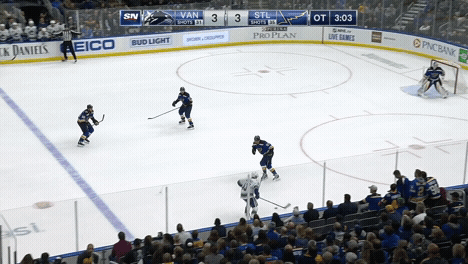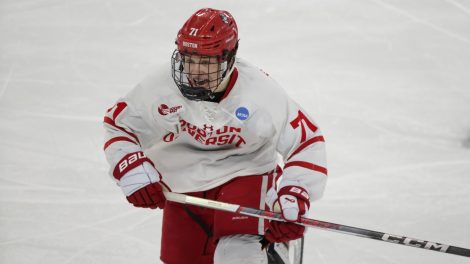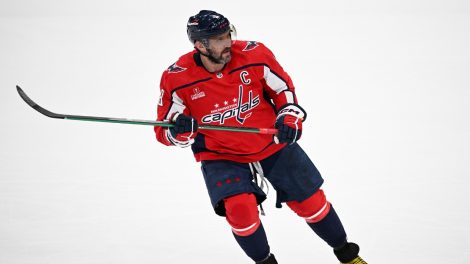Yes, we’re just over two weeks into the NHL season. Yes, the samples are still small. And, yes, the St. Louis Blues went from worst to first in a span of six months at the start of 2019 (in case you hadn’t heard).
But at some point “it’s too early” transitions into something more solid. The excuse that a bad stretch will turn around, or the warning that a surprising spurt will peter out due to small sample sizes will coalesce into more hardened analysis about what is going right, or wrong.
We may not quite be at that point yet — but we’re getting very close.
With five of Canada’s seven teams currently occupying a spot in the top half of the NHL standings, things have started off pretty well in the Great White North. But there are no teams here that will rival the 2018-19 Tampa Bay Lightning’s regular season dominance. In a league of parity, everyone has a weakness — but at the same time, even the bottom-feeders will have something going for them.
Here’s an expanded look at something good and something bad from each of Canada’s teams that we first touched on in this week’s Sportsnet NHL newsletter. For pieces like this and more (we also ranked the best off-season trade pickups this week) make sure to subscribe to the once-a-week email here:
[snippet id=4167285]
All “advanced” stats from Natural Stat Trick unless otherwise indicated.
TORONTO MAPLE LEAFS
The good: They always had the stars, but was their bottom six strong enough? Early returns are positive with Ilya Mikheyev (six points), Alexander Kerfoot (four points) and Trevor Moore (five points) all showing well. Moore, in fact, got promoted to the Tavares-Marner line to fill the sandpaper quota, and then when Tavares went down to injury Kerfoot got promoted, too.
Heck, the Leafs have gotten 55.36 per cent of the 5-on-5 scoring chances when fourth-liner Frederik Gauthier has been on the ice, which is a better split than either Marner or Tavares. We’ll mention their (poor) 5-on-5 goal differentials in a second, but the good news on that end is that the Leafs have the league’s second-best scoring chance percentage at 5-on-5 and only the 16th-best shooting percentage. You’d think more goals are to come there with all the weapons Toronto has. PDO (aka the luck stat) ranks the Leafs near the bottom of the league.
The bad: In four games against 2018–19 playoff teams, the Leafs have come away with just two points – and that was a win against Columbus, a very non-playoff team in 2020. Not ideal! Morgan Rielly has had his early-season play classified as a “struggle” which is troubling for a pre-season Norris hopeful and the only Leafs blueliner signed past this season.
Toronto’s power play is top 10 but, as alluded to above, they’ve been outscored 22-19 at 5-on-5 and have the league’s worst goals against per 60 minutes at 5-on-5 rate. In two starts, backup Michael Hutchinson has allowed nine goals, which is concerning because the league is trending in a direction that favours resting your starter more frequently in the regular season. So if the Leafs can’t get anything consistent from Hutchinson, they’ll either have to a) live with it and likely give up hope for the regular season division title b) somehow find another backup c) play Andersen 60 games or more for the fourth straight season.
MONTREAL CANADIENS
The good: Their putrid power play from last season has converted 23.1 per cent of its opportunities so far, which is well up from the 13.2 per cent efficiency it crawled along with in 2018-19, and ultimately cost them a playoff spot. Maybe there’s reason to believe the Habs could either maintain this level or stay close to it all season.
Eric Engels pointed out that all the success found on the power play so far has come from the sticks of the players on the second unit. That means Shea Weber hasn’t scored a PP goal yet. Brendan Gallagher has been shutout on the man advantage, too, and you know both of them will get going before long. At 5-on-5 Montreal has out-shot, out-chanced and out-scored the competition so far — and Carey Price hasn’t even got into his groove yet. Jonathan Drouin has shrugged off pre-season struggles and trade rumours for a point-per-game start.
The bad: Shea Weber hasn’t looked like himself. He’s been on the ice for seven of the 15 even-strength goals Montreal has allowed, and 14 of the 23 they’ve given up in all situations. Price isn’t to blame for anything, though Thursday’s shutout of a Minnesota team already in distress was the first game he allowed less than three goals in this season. More concerning might be the penalty kill, which is ranked 25th in the NHL currently with a 69.6 per cent rate after being a top 12 unit last season. Too often teams are allowed to attack the Canadiens with side-to-side passes that leave open a trigger man and Montreal hasn’t been able to adapt well enough yet.

OTTAWA SENATORS
The good: Vladislav Namestnikov was basically a salary dump for the New York Rangers, who sent the former Tampa Bay Lightning to Ottawa 11 days ago for a fourth-rounder in 2021, but he’s been a good fit early. Playing on the Sens’ second line, Namestnikov has found quick chemistry with Jean-Gabriel Pageau and Connor Brown — the trio has been Ottawa’s best line at even strength, and the only one with a positive shot differential. Those three players are Ottawa’s top scorers to this point.
What you mostly want to see from this team is development from the young players who will make up the core of a (hopefully) future contender. Thomas Chabot leads the entire league with an average ice time of 26:22 and Brady Tkachuk has been on the ice for more high danger chances for than against, while being physical and fun to watch. And, hey, they beat the Lightning!
The bad: A lack of butts in the seats is becoming a major concern as the Sens sit 30th in average attendance and 31st in capacity percentage through four home games. Some of this has to do with the inconvenience of where the Canadian Tire Centre is located and some likely has to do with the state and immediate hopes of the team. But mostly, this is about a lack of faith in ownership that has been brewing for years now. Until we get some positive news on the potential for a new arena at LeBreton Flats (which is nowhere right now), optimism is hard to come by in Ottawa, despite the fact the team does have a promising collection of young players and prospects.
[snippet id=3816507]
WINNIPEG JETS
The good: Patrik Laine got the top-line minutes he craved and has answered with 12 points in nine games — only three of which have been goals. This is great news because it signals much more could be on the way. Laine has not scored at all on the power play yet, but has led the Jets in that department each of the three years he’s been with the team. Their record is not great so far, but they have been able to stay around .500 with the depleted defence core and without second line centre Bryan Little, which has had a ripple effect on the rest of the lineup, explored by Sean Reynolds here. The Jets had the third-most wins when trailing after the first period in 2018-19 and that has also continued — they’re plucky as ever with a 3-0-0 record when playing from behind after 20 minutes.
The bad: They’re near the bottom of the league in shots against per 60 minutes of 5-on-5 action and high danger chances against per 60 minutes — so it comes as no surprise they’re leaking goals against. After a 5-2 win against lowly Minnesota in their home opener, the Jets dropped their next three at MTS Centre by a combined 14-5 score against injured Pittsburgh, goal-starved Arizona and the Even Steven NY Islanders. Their penalty kill, which ranked 22nd in the NHL last season, has somehow been even worse in 2019-20 by getting out of shorthanded situations without giving up a goal just 56.3 per cent of the time.
[relatedlinks]
CALGARY FLAMES
The good: Cam Talbot has only been given one start so far because David Rittich has been so strong — a great sign since we still had to learn whether or not he was a No. 1 this season. So far, he’s passing that test. Helping that along is the fact Calgary allows 8.06 high danger chances against per 60 minutes of 5-on-5 play, which is among the 10 best defences in the league. They’ve had to kill the 10th-most penalties (which would fall into the “bad” category) but have the seventh-best kill rate so far. Johnny Gaudreau, Matthew Tkachuk and Elias Lindholm have lived up to expectations, while Mark Giordano is making us start to think that his Norris Trophy-winning season at age 35, in which he posted a career-best 74 points, may be attainable once again.
The bad: The power play has been slow to find success after it finished in the bottom half of the NHL last season as well. Meantime, the Flames have been outscored at 5-on-5 by two — a gap they halved after Thursday’s lopsided win against the Red Wings, but could widen again with a tough upcoming schedule. Depth up front remains a bit of a concern. While the top two lines pull their weight, the bottom-six has had one strong game on offence — again, against the lowly Red Wings. They’re still figuring out how those bottom two lines should look. They’re 1-2-1 against divisional opponents and have been outscored 13-9 by them.
VANCOUVER CANUCKS
The good: Elias Pettersson looks as good as ever, costly trade pickup JT Miller leads them in scoring with eight points in six games, Jacob Markstrom has a solid .926 save percentage and when he had to step away for a couple games for personal reasons, goalie of the future Thatcher Demko won two games in relief, posting a .938 save percentage. By goal differential alone, the Canucks are Canada’s best 5-on-5 team right now, outscoring the competition 16-12, the seventh-best split in the league. Quinn Hughes looks comfortable on NHL ice averaging more than 20 minutes a game and his 16 zone entries (all strengths) ranks tied for sixth among all NHL defencemen, while his 35 zone exits rank 10th, per Sportlogiq.

The bad: While the 5-on-5 goal differential is very good at the moment, the Canucks have the eighth-worst shot differential in that situation to this point and are bottom-10 in high danger chance differential at 5-on-5. Their shooting percentage is second-highest in the league right now, a huge contributing factor to their goal splits, and you have to think that’ll catch up to them eventually. Looking back at PDO (the “luck” stat we touched on earlier) the Canucks rank fourth in the league, which really drives the point home that some kind of course correction is on the horizon.
EDMONTON OILERS
The good: Connor McDavid and Leon Draisaitl are the highlights. Draisaitl leads all NHL forwards with an average ice time per game of 24:23 and McDavid is currently third at 22:30 — and they are the top two in even strength ice time. James Neal has been a revelation, already surpassing his goal total from all of last season in Calgary. But what really shows how this year’s team could be different is how they’re not giving up and are showing a streak and ability to fight back. Edmonton trailed at some point in five of their six wins so far and were able to come away with two points instead of folding. The jury was out on how good Mikko Koskinen (or how weak his glove and) really was, but so far he’s been fantastic.
The bad: Depth, especially up front, remains a huge question mark. Though the power play is on fire with a league-best 45.5 per cent success rate, at 5-on-5 the Oilers have been outshot by 37, and Tomas Jurco is the only non-top-six forward with a point at 5-on-5. In fact, no line has outshot its opponents in this situation and the Oilers have the league’s fifth-worst scoring chance differential per 60 minutes of 5-on-5 play. As great a story as Neal has been thus far, six of his eight goals have come on the power play, which itself is clicking at a wholly unsustainable pace. It’s obvious that his scoring pace will cool — when it does and some of the team averages come back to normal, the Oilers’ fortitude will be put to the test and that’s when we’ll really start to understand if this is real or not.









